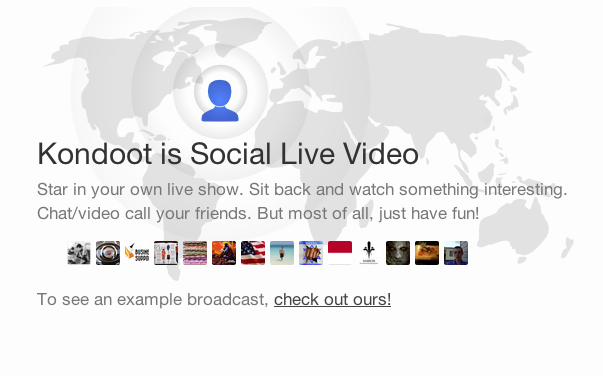Social live video network Kondoot: Australia’s answer to Facebook?
NEW social network Kondoot lets you stream yourself to all your friends. Will it catch on? Myriam Robin reports.
It’s not often that one sees a new internet phenomenon come out of Queensland, so when I heard about Kondoot, I had to find out more. When I emailed the founders asking them for an interview, they had only one condition.
“Let’s do it over Kondoot,” founder Matt Cracknell said.
“But I don’t have a webcam,” I responded.
Matt assured me that wouldn’t be a problem.
And so I was plunged head-first into the new social network, frantically trying to learn the system in the ten minutes or so I had before our interview would start.
Kondoot is a social network based around video. It’s not like YouTube, because it’s live-streamed. It’s not Skype, because it’s only not just between two people. And it’s not like Justin TV or any of the other live-casting websites out there, because it offers a whole social network around this functionality.
How does Kondoot work? Essentially, you go to a friend’s page. They might have a live-stream going of themselves. To the side of that is an instant-messaging service. You can either IM them, or you can simply post on their wall much like you would on Facebook. The layout is clean and minimalistic, and while it took me a few minutes to learn my way around, it certainly wasn’t very hard.
The Kondoot founders have a joint profile, which constantly beams their working selves to the world. When I clicked on their profile, I saw a half dozen of them hunched over various computer screens. The camera was mounted high on the wall, giving me a clear view of the room. It felt voyeuristic in a way.

Voyeuristic much? An example of a broadcast from the Kondoot office where staff beam their working selves to the world.
They set up a private screening with me so I could ask my questions, and the first one I typed was whether it was strange being watched all the time. Nathan Hoad, another founder, said it had been at first. But they’d gotten used to it, though one of them (he wouldn’t say who) had once been caught picking his nose.
After this, a technical fault meant I wasn’t receiving all the chats, so we moved to a telephone to finish the interview. I could see them hunched over Nathan’s computer trying to fix the problem while they called me. Again, voyeuristic, but cool.
On the phone now, Nathan told me how their main launch had been a month ago. Since then, they’ve seen a massive spike in traffic, mostly from the United States, but also from 123 other countries. It’s been getting a lot of attention not only from users, but from the media and investors as well.
Despite politicians not normally being rapid embracers of social media, Kondoot has been used by Queensland Liberal National Party Leader Campbell Newman to communicate with his supporters.
Nathan said the biggest thing they’d learnt was to trust their users. People have been using the technology in ways the founders hadn’t imagined, for instance, hosting live cooking shows.
The challenge ahead for Kondoot is a big one – standing up to social media giants like Facebook and Google+ who have the money and the reach to rapidly pick and implement features that prove popular on other social networks. For example, within weeks of Google+ launching, Facebook improved it’s friend-sorting and privacy functions to match Google’s “circles” feature which allows you to dictate what information to share with which circle of relationships.
But then again, the proverbial stoning of the giant Goliath by the likes of young David upstarts isn’t something new in the world of tech either.
Have you tried Kondoot? What would you use it for? Share with us in the comments section below.

